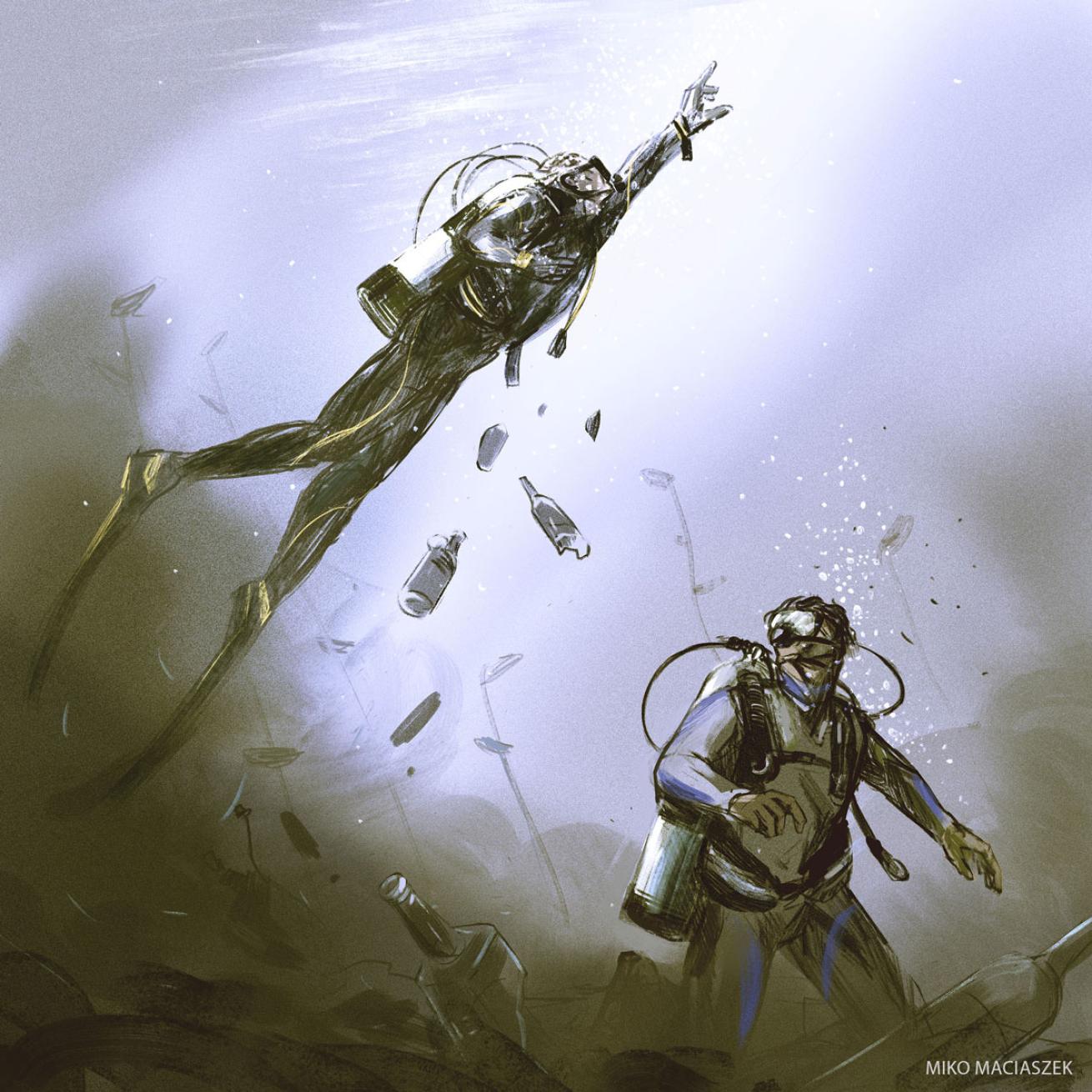Lessons For Life: Asthmatic Diver
Stan’s buddy Steve had shown him dozens of antique bottles Steve had collected from a river bottom not far from where they lived, and Stan wanted to find some of his own. He wanted a few to display at his house, but he also was hoping to sell some online to make some quick cash.
They had been planning the dive a while, but weather and other delays kept coming up. Stan was determined to make the dive this morning — nothing was going to stop him. Feeling a familiar tightness in his chest, Stan took two deep puffs from his inhaler before he got in the water.
He had asthma, but he wasn’t about to let that keep him out of the water.

Miko MaciaszekWhat was the final trigger that caused Stan to panic and bolt for the surface?
THE DIVER
Stan was a 27-year-old diver with an open-water certification. He had been certified for several years but rarely made more than a few dives a year. He enjoyed it, but life and other priorities often got in the way.
He had been diagnosed with asthma as a child, but unlike many of his peers, he never outgrew the condition. Sometimes it bothered him more than other times — typically, cold air or exertion seemed to bring on an asthma attack. He used his inhaler occasionally, and never more than twice a week.
THE DIVE
It was a cool fall morning when Stan and Steve showed up at the river access for the artifact dive. The site had been a dumping area for river-boats that plied the region in the late 19th and early 20th centuries. Boat crews would tie off just outside town to off-load cargo and exchange full barges for empty ones. They would often dump their garbage directly into the river. Glass bottles and other non-biodegradable refuse sat on the bottom, until local divers realized what was waiting for them.
The river was 15 feet deep where Stan and Steve planned to dive; the water temperature was in the low 50-degree range. Visibility was poor.
On good days, it could get up to 5 feet, but more often the viz was fewer than 2 feet. Stan and Steve were diving close to shore, but there was still a constant current of about a mile per hour.
Both divers were wearing heavy wetsuits, hoods and gloves. To make the dive, they would overweight themselves and descend directly to the bottom. Using long stakes, they would hold themselves in place while they dug in the silt on the bottom, searching for bottles and other artifacts. Digging in the mud reduced what little visibility they had to zero.
THE ACCIDENT
Recent high water from several storms had changed the river bottom and uncovered fresh piles of bottles. Stan and Steve found an area rich with artifacts, and ended up making several bounce dives to the bottom to collect bottles and bring them to the surface. They were excited by their find and didn’t want to quit.
The two divers attempted to stay together, ascending and descending at the same time, but the lack of visibility made that difficult. Just after descending for the fourth time, Steve noticed that Stan was struggling. In an instant, he realized Stan had bolted for the surface. Steve followed more slowly, making a safe ascent, and saw Stan sinking below the surface again, unconscious. Steve quickly grabbed him and dragged him to the shore.
He performed CPR, but Stan never regained consciousness. The investigation showed that Stan had about 1,000 psi of air left in his tank. The autopsy disclosed intravascular, intracardiac and subcutaneous gas. This meant Stan had air bubbles in his arteries and veins, in his heart, and underneath the skin around his chest and throat. The medical examiner ruled Stan’s death a drowning, secondary to having an air embolism.
ANALYSIS
Several factors combined to lead to this fatality. The bigger question is, what was the final trigger that caused Stan to panic and bolt for the surface?
We can only surmise, but this was a stressful dive. Low visibility, cold water and a strong current all combined to increase the workload for the two divers. Stan hadn’t been diving recently, so he might have been a bit rusty.
An air embolism — also called arterial gas embolism, or AGE — happens when air is trapped in a diver’s lungs at depth. On ascent, the air expands.
If the trapping and ascent continue, it can tear a hole in the lung tissue. This is known as pulmonary barotrauma and is the reason the cardinal rule of diving is never hold your breath. If expansion of the air tears the lung tissue, air can enter the bloodstream and go to the brain. AGEs can cause stroke-like symptoms, unconsciousness or death. These symptoms happen have led to panic and rapid ascent.
There are many divers who dive regularly with asthma and have no problem. For years, asthma was considered an absolute contraindication to scuba diving. The current consensus on diving with asthma is that if it is well-controlled, the diver should understand the relative risks of the event and be allowed to dive. The first recommendation for divers with asthma is that they not dive if their asthma attacks are induced by exercise or cold. Either of those would have disqualified Stan from diving.
LESSONS FOR LIFE
1 Exercise- or cold-induced asthmatics should not dive. (The British Sub Aqua Club [BSAC] adds “emotional attacks.”)
2 Asthmatics requiring “rescue or reliever” medication should not dive. Asthmatics on chronic maintenance bronchodilation and inhaled steroids are thought to be able to dive. Recommendations vary, however, and the BSAC suggests that asthmatics should not dive if he or she has needed a therapeutic bronchodilator in the last 48 hours or has had any other chest symptoms. They feel that the asthmatic should not need more than occasional bronchodilators — i.e., daily usage would be a disqualifying factor — but inhaled steroids/cromoglycate/nedocromil are permissible.
3 Mild to moderate asthmatics with normal screening spirometry can be considered candidates for diving (FEV1/FVC ratio above 85 percent of predicted).
4 If an asthmatic has an attack, screening spirometry should be done, and the individual should not dive until his airway function returns to normal.
DIVING WITH ASTHMA
1 BE PREPARED Trying something new? Make certain you have the necessary training and experience. Make sure you are fit — both physically and skills-wise — for the dive.
2 DON’T PANIC If you find yourself in a situation where you are growing uncomfortable, stop, breathe, think and then act. Don’t react.
3 MAKE GOOD CHOICES Don’t let the desire of wanting to make a dive override caution.
4 CONTROL YOUR ASTHMA If you are asthmatic, dive with an abundance of caution, and dive only when it is well-controlled.
ABOUT THE AUTHOR
Eric Douglas co-authored the book Scuba Diving Safety, and has written a series of adventure novels, children’s books, and short stories — all with an ocean and scuba diving theme. Check out his website at booksbyeric.com and follow him on Facebook at facebook.com/EricDouglasAuthor.










